spare tire AUDI A4 AVANT 2008 Owners Manual
[x] Cancel search | Manufacturer: AUDI, Model Year: 2008, Model line: A4 AVANT, Model: AUDI A4 AVANT 2008Pages: 368, PDF Size: 46.19 MB
Page 5 of 368
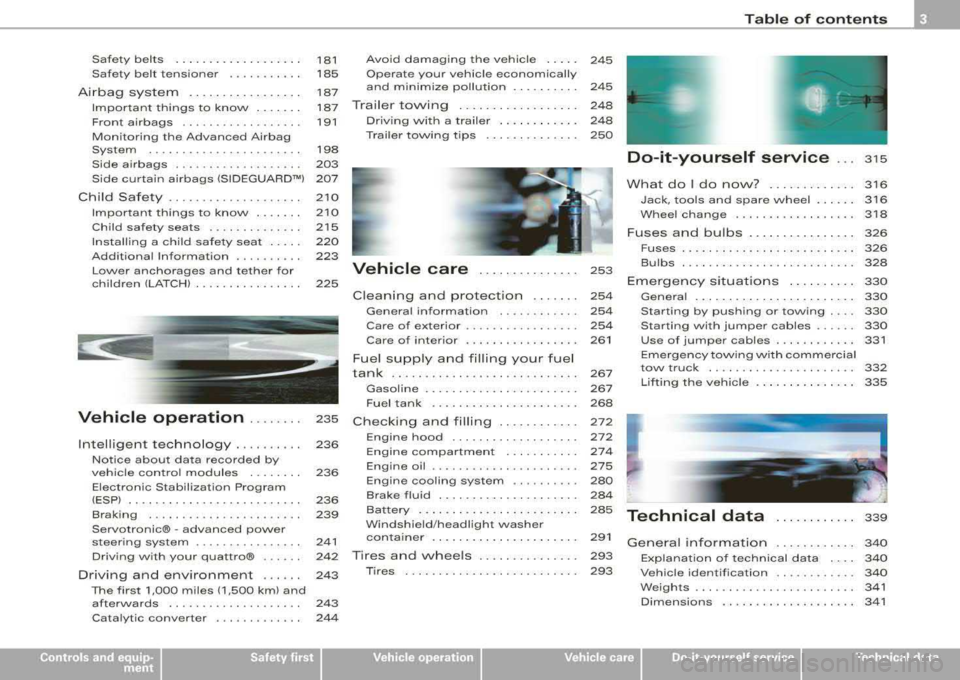
Safety belts .................. .
Safety belt tensioner ..... ... .. .
Airbag system ........ .... .. .. .
Important th ings to know .. .... .
Front airbags .. ... .. ... ...... . .
Monitoring the Advanced Airbag
System ... ..... .... ..... .. ... .
Side airbags .... ... ...... ..... .
Side curtain airbags (SIDEGUARD™l
Child Safety .. ... ... ..... ... ... .
Important things to know .... .. .
Child safety seats ........ ... .. .
Insta lling a ch ild safety seat .... .
Addit ional Information .... ..... .
Lower anchorages and tether for
chi ldren (LA TCH) .......... ... .. .
t
181
185
187
187
191
198
203 207
210
210
215
220
223
225 Avoid damag
ing the vehicle .....
Operate your vehicle economically
and minimize pollution ......... .
Trailer towing .......... ... .. .. .
Driv ing w it h a trailer ... .... .... .
Trai ler towing t ips ....... ...... .
Vehicle care ........ ... ... .
C lean ing and protection ...... .
Genera l information ........... .
Care of exterior ....... .. .. .. ... .
Care of interior ................ .
Fuel supply and filling your fuel
tank ........ .... .. ... .... ...... .
245
245
248
248
250
253
254
254
254
261
267
Gasoline . . . . . . . . . . . . . . . . . . . . . . . 267
Fuel tank . . . . . . . . . . . . . . . . . . . . . . 268
Vehicle operation . . . . . . . . 235 Checking and filling . . . . . . . . . . . . 212
Intelligent technology ... ...... .
Notice about data recorded by
veh icle contro l modules ....... .
Electronic Stabilization Program
(ESP) ......................... .
Braking .. ... ... ... ... ... .. ... .
Servotronic®
-advanced power
steering system . ......... .. ... . 236
236
236
239
241
Driv ing w ith your quattro® . . . . . . 242
Driving and environment . . . . . . 243
The first 1,000 miles (1,500 kml and
afterwards . . . . . . . . . . . . . . . . . . . . 243
Cata lytic conver ter . . . . . . . . . . . . . 244 Engine
hood ......... ......... .
Engine compartmen t .... ... ... .
Engine oil ... ...... ... ....... .. .
Engine cooling system .. .... ... .
Brake fluid . ............... .... .
Ba ttery ...... .......... .... ... .
Windshield/headlight washer
con ta iner .. ........ ... ........ .
Tires and whee ls ..... ......... .
Tires .......... ...... .. .. ..... . 272
2 74
275
280
284
285
291
293
293
Tabl e of cont ents
Do-it-yourself service . . . 3 15
What do I do now? . ......... ... 316
Jack, tools and spare wheel . . . . . . 316
W hee l change ............... ... 318
Fuses and bulbs . . . . . . . . . . . . . . . . 326
Fuses ........ ......... ..... .... 326
Bu lbs .............. ... ... ... ... 328
Eme rgency sit uations . . . . . . . . . . 330
Genera l . . . . . . . . . . . . . . . . . . . . . . . . 330
Starting by pushing or towing . . . . 330
Starting with jumper cables . . . . . . 330
Use of jumper cables . . . . . . . . . . . . 331
Emergency tow ing with comme rcial
tow truck . . . . . . . . . . . . . . . . . . . . . . 332
Lif ting the vehicle . . . . . . . . . . . . . . . 335
Technical data
General in for matio n
339
340
E xplanat ion of technical data . . . . 340
Vehicle identification . . . . . . . . . . . . 340
Weights . . . . . . . . . . . . . . . . . . . . . • . . 341
Dimensions . . . . . . . . . . . . . . . . . . . . 341
irechnical data
Page 48 of 368
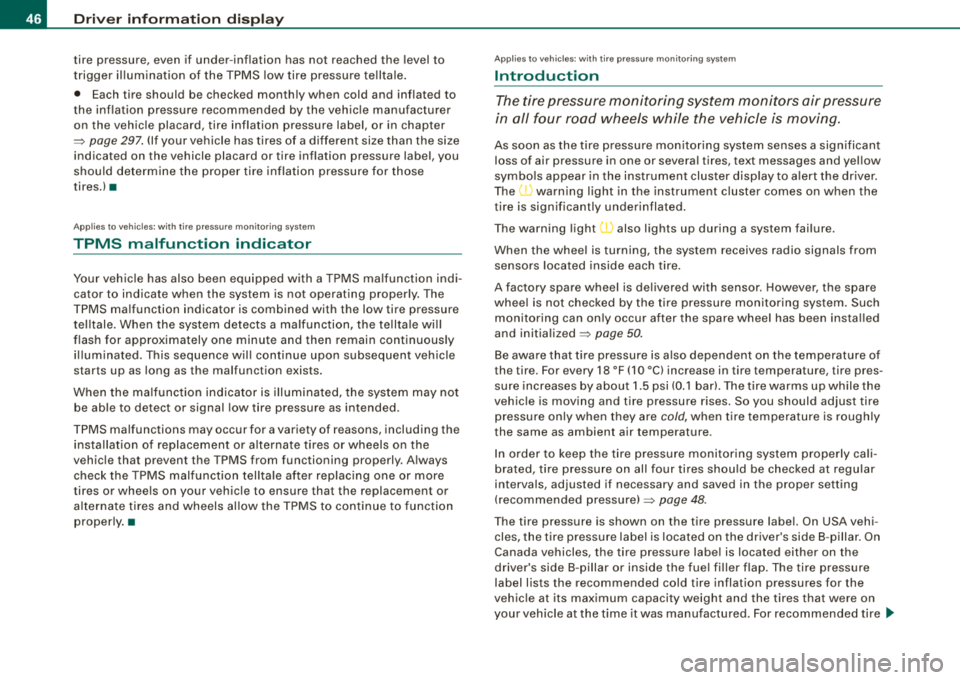
Driver inf ormation di spl ay
tire pressure, even if under-inflation has not reached the level to
t rigger il lum ination of the TPMS low tire pressure te llta le .
• Each tire should be checked month ly when cold and inflated to
the infla tion pressure recommended by the vehic le manufacturer
on the vehicle placard , tire inflation pressure label, or in chapter
=> page 297 . (If your ve hicle has tires o f a different size than t he size
indicated on the vehicle placard or tire inf lation pressure label, you
should de termine the proper tire inflation pressure for those
tires.) •
Applies to vehi cles : with tire p ress ure mo nit o ring system
TPMS malfunction indicator
Your vehic le has also been equipped with a TPMS ma lfunction indi
cator to indicate when the system is not operating properly. The
TPMS ma lfunct ion indicator is combined with the low tire pressure
telltale . When the system detects a ma lfunction, t he tellta le wi ll
f lash for approximately one minute and then remain continuous ly
il lum inated. T his sequence wil l continue upo n subsequent veh icle
star ts up as long as the malfunction exists.
When the ma lfunc tion ind icator is ill uminated, the system may not
be able to detect or signal low tire pressure as intended .
TPMS malfunctions may occur for a variety of reasons, including the
installation o f rep lacement or a lternate tires or wheels on the
vehic le that prevent the TPMS from functioning properly . A lways
check t he TPMS malfunction tellta le after replac ing one or more
tires or whee ls on your v ehicle to ensur e that the replacement or
a lternate t ires and wheels al low the TP MS to continue to function
proper ly. •
Ap plies to ve hicles : w it h tir e pressu re m oni to ring sy ste m
Introduction
T he tire pressure monitoring system monitors air pressure
in all four road wheels while the vehicle is moving.
As soon as the tire pressure monito ring system se nses a significant
loss of air pressure in one or several tires, text messages and yel low
symbo ls appear in the instrument clus ter disp lay to a lert the driver.
The
(l) warning light in the instrument cluster comes on when the
t ire is significa ntly under inflated.
The warning light
(l) also lights up during a system failure .
When the whee l is turning, the system receives radio signals from
sensors located inside each tire.
A factory spare wheel is delivered with sensor . However, the spare
whee l is not checked by the ti re pressure monitoring sys tem. Such
monitoring can on ly occur after the spare wheel has been insta lled
and
initia lized => page 50.
Be aware that t ire pressure is a lso dependent o n the temperature of
the tire . For every 18 °F (1
O °C) increase in tire temperature, tire pres
su re increases by about 1.5 psi (0 .1 barl. The tire warms up wh ile the
vehic le is moving and t ire pressure rises. So you should adjust tire
pressure only when they are
cold, when tire temperature is roughly
the same as ambient air temperature .
I n order to keep the tire pressure moni toring system prope rly ca li
brated, tire pressure on all four tires shou ld be checked at regular
intervals, adjusted if necessary and saved in the proper sett ing
(reco mmended
pressure) => page 48.
The tire pressure is shown on the tire pressure label. On USA vehi
cles, the tire pressure label is located on the dr iver's side B -pillar. On
Canada vehicles, the tire pressure labe l is located either on the
driver's side B -p illar o r inside the fue l fi ller flap. The tire pressure
label l ists the recommended cold tire inflation pressures for the
vehic le at its maximum capacity weight and the tires that were on
your vehicle at the t ime it was manu factured . For recommended tire
~
Page 51 of 368
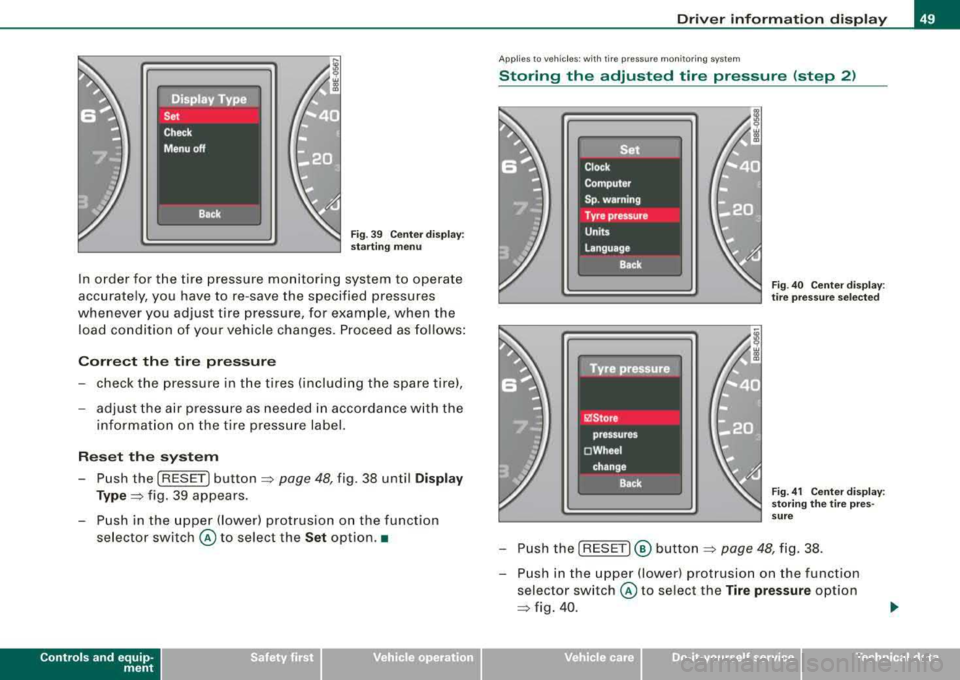
Fig. 39 Center display :
starting menu
In order for the tire pressure monitoring system to operate
accurately, you have to re-save the specified pressures
whenever you adjust tire pressure, for example, when the load condition of your vehicle changes. Proceed as follows:
Correct the tire pressure
- check the pressure in the tires (including the spare tire),
- adjust the air pressure as needed in accordance with the
information on the tire pressure label.
Reset the system
Push the [RESET] button=> page 48, fig. 38 until Display
Type=> fig. 39 appears.
- Push in the upper (lower) protrusion on the function selector switch
@ to select the Set option. •
Controls and equip
ment
Driver information display
Applies to veh ic les : w ith tir e pressure mon itoring system
Storing the adjusted tire pressure (step 2)
Fig . 40 Center display :
tire pressure selected
Fig. 41 Center display:
storing the tire pres
sure
- Push the [RESET]® button => page 48, fig. 38.
- Push in the upper (lower) protrusion on the function
selector switch
@ to select the Tire pressure option
=> fig. 40.
irechnical data
Page 299 of 368
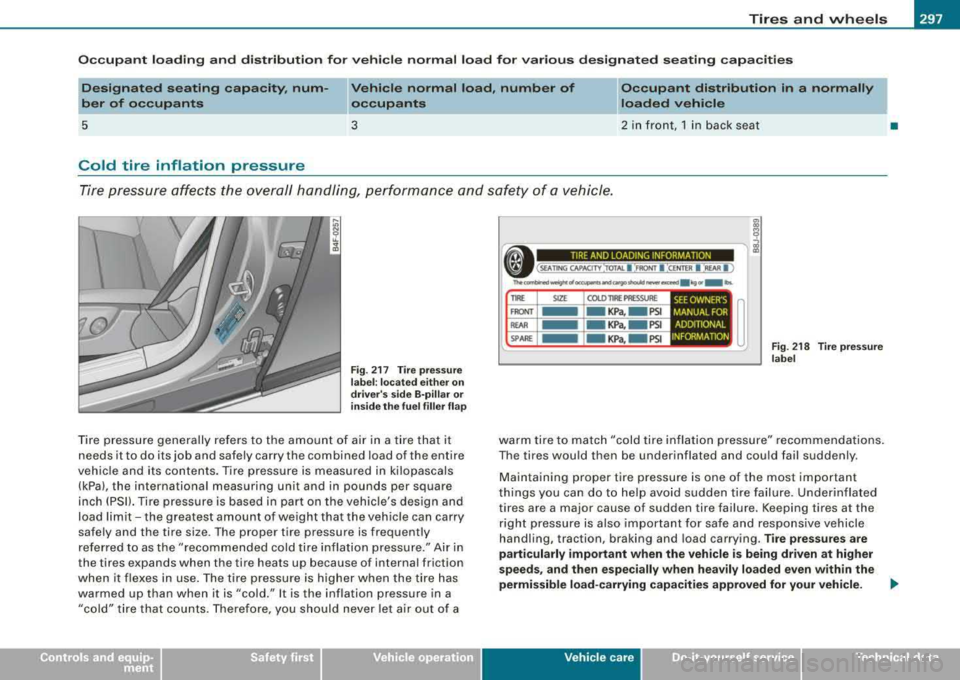
________________________________________________ T_ i_ r _e _s _ a_n_ d_ w_ h_ e_e _l_s _ __._
O cc upant loading and distribution for vehicle no rmal load for various d esignated s eating capa cities
Designated seating capacity , num
ber of occupants
5
Cold tire inflation pressure
Vehicle normal load , number of
occupants
3
Occupant distribution in a normally
loaded vehicle
2 in front, 1 in back seat
T ire pressure affec ts the overall ha ndling, performan ce and safety of a vehicle.
Fig . 21 7 Tire pre ssu re
label : located eit her on
driver's side B-pillar or
in side the fuel filler fl ap
ill
9 ,-, ~ ------------------.. j;l
• (SEATING CAPAQlY :rorAL I :FRONT I : cENTER I :REAR I ) m
Thea,mtwd""'9/Wdoocu,,.....andQ1Vo.....,.....,-,ed .logo, _ .,.
TIRE AND LOAD ING INFORMATION
TIRE SIZE COLO TIRE PRESSURE
FRONT -KPa, -PSI
REAR -KPa, - PSI
SPARE -KPa, -PSI
MANUAL FOR
INFORMATION SEE OWNER'S I
ADDITIONAL
Fig . 218 T ir e pr essu re
label
w arm tir e to matc h "cold t ire in flation press ure" recommenda tions .
The tires wou ld then be underinflated and cou ld fai l suddenly .
M aintaini ng proper t ire pressure is one of the most im po rta nt
thi ngs you ca n do t o help avo id sud den t ire fa ilu re. Underi nflated
tires are a major cause of sudden tire failure. Keeping tires at the
ri ght pressure is also importa nt for safe and r espo nsive ve hicle
handling, traction, braking and load carrying.
Tire pressures are
particularly important when the vehicle is being driven at higher
speed s, and then especially when heavily loaded even within the
•
T ire pressure generally refe rs to the amou nt of air in a t ire that it
needs it to do its job and safely carry the combined load of the entire
veh ic le and i ts c ontents. Tire p ressu re is measu red in kilopascals
(kPa), the international measuring unit and in pounds per square
inch (PSI) . Tir e p res su re is based in part on th e vehic le's design and
load lim it - the greatest amount of weight that the veh ic le can carry
safely and the tire size . The proper tire pressure is frequently
re ferred to as the "recommended cold t ire infla tion pressure." A ir in
the tires expands when the tire heats up because of internal friction
when it fl exe s i n us e. The tir e press ure is high er w he n th e t ire has
warmed up than when it is "cold." It is the inflation pressure in a "c old" tire that c ounts. Theref ore , yo u sho uld never le t air ou t of a
permissible load -carrying capacities approved for your vehicle. ...
Ve hic le care Technical data
Page 302 of 368
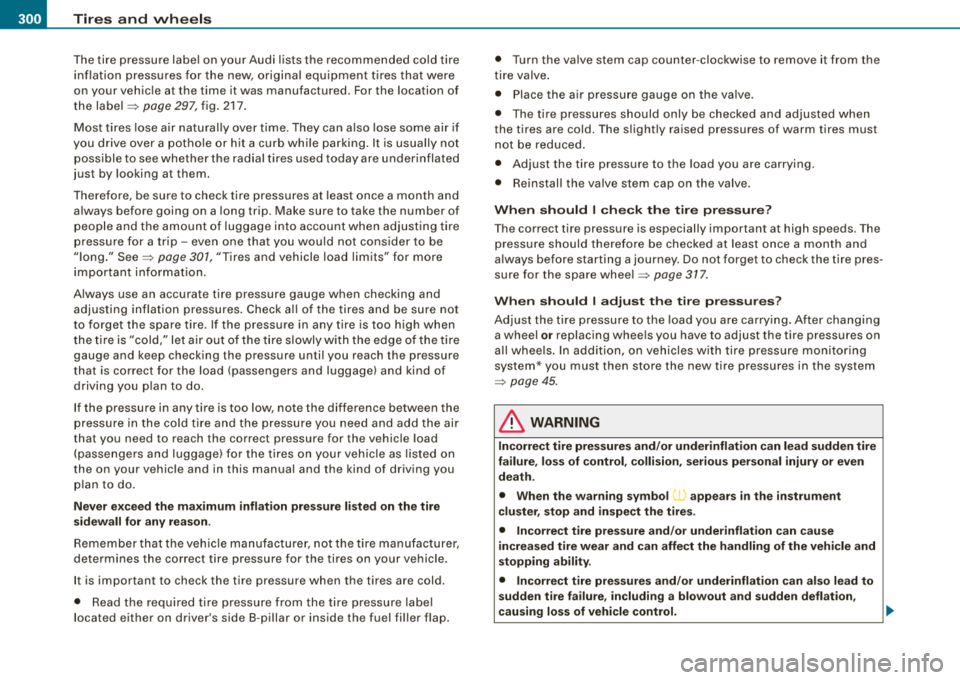
___ T_ ir_e _ s_ a_ n
_ d_ w_ h_ e_ e_ls _________________________________________________ _
The tire pressure label on your Audi lists the recommended cold tire
inf lation pressures for the new, original equipmen t tires that were
on your vehic le at the time it was manufactured . For the location of
the
labe l=> page 297, fig. 217 .
Most tires lose a ir natural ly over time. They can a lso lose some air if
you drive over a potho le or hit a curb wh ile parking. It is usually not
possible to see whether the radial t ires used today are under inflated
just by looking at them.
Therefore, be su re to check tire pressures at least once a month and
always before going on a long trip . Make sure to take the number of
people and the amount of luggage into account when adjusting tire
pressure for a trip -even one that you wou ld not cons ider to be
" long ."
See => page 301, "Tires and vehicle load limits" for more
important i nformation .
A lways use an accurat e tire pressure gaug e when checking and
adjusting inflat ion pressures. Check a ll of the tires and be sure not
to forget the spare tire . If the pressure in any tire is too high when
the t ire is "cold," let air o ut of the t ire slowly with the edge of the tire
gauge and keep check ing the pressure until you reach the pressure
that is correct for the load (passengers and luggage) and kind of
driving you p lan to do .
I f the pressure in any tire is too low, note the difference between the
pressure in the co ld tire and the pressure you need and add the air
that you need to reach the correct pressure for the vehicle load
(passengers and luggage) fo r the t ires on your veh ic le as listed on
the on your vehicle and in this manual and the kind of driving you pl an to do .
Never exceed the m aximum inflation pressure li sted on the tire
s idewall for an y re ason .
Remem ber that the vehic le manufacturer, not t he tire manufacturer,
determines the correct tire pressure for the tires on your vehicle .
I t is important to check the tire pressure when the tires are cold.
• Read the required tire pressure from the t ire pressure label
located either on driver 's side B -pillar or inside the fuel fi ller flap . •
Turn the va lve stem cap counter -clockwise to remove it from the
t ire valve .
• Place the air pressure gauge on the valve.
• The tire pressures should only be checked and adjusted when
the tires are cold. The s lightly raised pressures of warm tires must
not be reduced.
• Adjust the tire pressure to the load you are carrying.
• Reinstal l the va lve stem cap on the valve .
When should I check the tire pressure?
The correct tire pressure is especially important at high spe eds . The
pressure should the refore be checked at least once a mo nth and
a lways before starting a journey. Do not forget to check the tire pres
sure for the spare whee l
=> page 317.
Wh en should I adjust th e tir e pre ssur es?
Adjust t he tire pressure to the load you are carry ing . After changing
a wheel
o r replacing whee ls you have to ad just the tire pressures on
a ll whee ls . In addition, on vehicles w ith tire pressure monito ring
system* you must then store the new tire pressures in the system
=> page 45.
& WARNING
Incorrect tire pre ssure s and /or underinflation can lead sudden tire
f ai lure , loss of control , collision , seri ous per sonal injury or even
death.
• When the w arning symbol
(l) appe ars in the in strument
clu ster , stop and inspect the tire s.
• Incorrect t ire pres sure and /or underinflat ion can cause
increa sed tire wear and can affect the handling of the vehicle and
s topping ability.
• Incorrect tire pres sures and /or underinflation can also lead to
s udden tire fa ilure , inc luding a blowout and sudden defl ation ,
cau sing los s of vehicle control .
~
Page 307 of 368
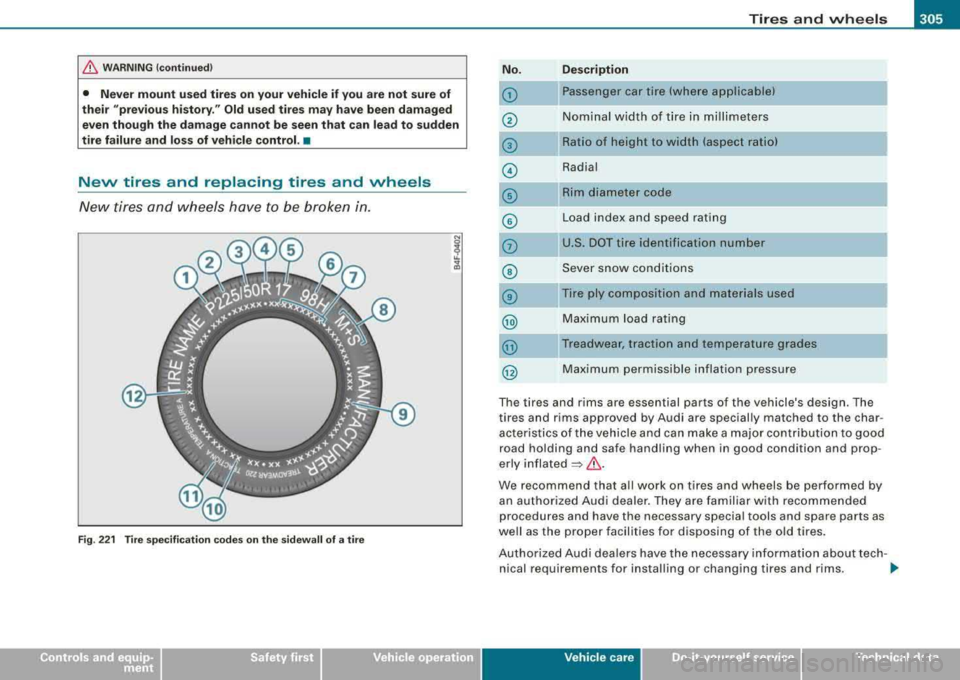
__________________________________________________ T_ ir_e _ s_ a_ n
_ d_ w_ h_ e_ e_ls _ __. 11111
/b, W ARNING (continued )
• Never mount u sed tires on your vehicle if you are not sure of
their "previou s history. " Old used ti res may ha ve been damaged
even though the damage cannot be seen that can lead to sudden
tire failu re and loss of vehicle control.
•
New tires and replacing tires and wheels
N ew tires and wheels have to be bro ken i n.
12
9
Fig . 22 1 Tire spe cificati on code s on the sidewall of a tire
No .
0
@
®
©
©
Description
Passenger car tire (where applicable)
Nominal w idth o f tire in mi llime ters
Ratio of height to width (aspect ratio)
Radia l
Rim diameter code
© Load index and speed rating
0
©
©
@)
1ju.s. DOT tire identification number
Sever snow cond itions
Tire ply composition and materials used
Max imu m load rating
@ Treadwear, traction and temperature grades
@ Maximum permissible inflation pressure
The t ires and rims are ess ential parts of the ve hicle's design . T h e
tires and rims approved by Audi are specially matched to the char
ac ter is ti cs of th e vehicle and can mak e a major contribution to good
road holding and safe hand ling when in good condition and prop
erly i nflated
=> /b, .
We recommend that a ll work on tires and wheels be perfo rmed by
an au thorized Audi dealer . They a re familia r with recommended
procedures and have the necessary specia l tools and spare parts as
we ll as the proper facilities fo r dispo sing of the o ld tires.
Authori zed Audi d ea lers have the n ecessa ry in for mati on abo ut tec h-
nical requirements for instal ling or changing tires and rims . _...
Vehic le care Technical data
Page 310 of 368
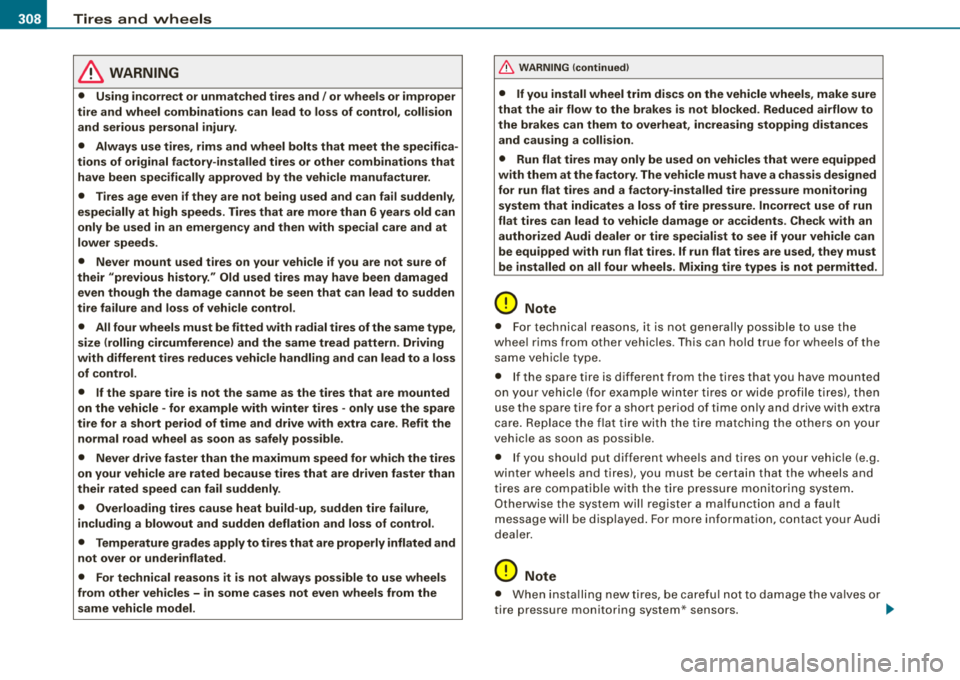
___ T_ ir_e _ s_ a_ n
_ d_ w_ h_ e_ e_ls _________________________________________________ _
& WARNING
• Using incorrect or unmatched tires and / or wheels or improper
tire and wheel combinations can lead to loss of control , collision
and serious personal injury .
• Always u se tires , rims and wheel bolts that meet the specifica
tions of original factory -installed tires or other combinations that
have been specifically approved by the vehicle manufacturer.
• Tires age even if they are not being used and can fail suddenly ,
especially at high speeds . Tires that are more than 6 years old can
only be used in an emergen cy and then with special care and at
lower speed s.
• Never mount used tires on your vehi cle if you are not sure of
their "previous history." Old used tires may have been damaged
even though the damage cannot be seen that can lead to sudden
tire failure and loss of vehicle control.
• All four wheels must be fitted with radial tires of the same type ,
size (rolling circumference ) and the same tread pattern. Driving
with different tires reduces vehi cle handling and can lead to a loss
of control.
• If the spare t ire is not the same as the tires that are mounted
on the vehicle -for example with winter tires -only use the spare
tire for a short period of time and drive with extra care . Refit the
normal road wheel as soon as safely possible.
• Never drive faster than the ma ximum speed for wh ich the tires
on your vehicle are rated because tires that are driven faster than
their rated speed can fail suddenly .
• Overloading tire s cause heat build -up , sudden tire failure ,
including a blowout and sudden deflation and loss of control.
• Temperature grades apply to tires that are properly inflated and
not over or underinflated .
• For technical reasons it is not always possible to use wheel s
from other vehicles - in some cases not even wheels from the
same vehicle model.
& WARNING (continued )
• If you install wheel trim discs on the vehicle wheels, make sure
that the air flow to the brakes is not blocked . Reduced airflow to
the brakes can them to overheat , increasing stopping distances
and causing a collision .
• Run flat tires may only be used on vehicles that were equipped
with them at the factory. The vehicle must have a chassis designed
for run flat tires and a factory-installed tire pressure monitoring
s ystem that indicate s a loss of tire pressure . Incorrect use of run
flat tires can lead to vehicle damage or ac cidents . Check with an
authorized Audi dealer or tire specialist to see if your vehicle can
be equ ipped with run flat tires . If run flat tires are used , they must
be installed on all four wheels . Mixing tire types is not permitted.
0 Note
• For tec hnical r eas ons, it is no t gene rally possible to use the
whee l rims from other vehicles . ihis can hold true for wheels of the
same ve hicle type.
• I f the spare tire is different from the tires that you have mounted
on y our ve hicle (f or exampl e wi nter t ires or wide p ro fi le tir es), then
use the spa re tire fo r a short per iod of time on ly and d rive with extra
c a re . Rep lace the flat t ire wi th the ti re m atc h ing t he oth ers o n you r
vehic le as soon as possib le .
• If yo u should put diff eren t w heels a nd tires on yo ur vehi cle (e. g.
winter wheels and tires), you must be certa in that the wheels and
t ires a re co mpatibl e w ith the tire press ur e m onit orin g sys te m.
Otherwise the system will regist er a ma lfunction and a fau lt
mes sage wil l be d isp layed . Fo r mo re info rmation, contact yo ur Audi
dea ler .
0 Note
• When i nsta lling new ti res, be care fu l n ot to damage t he va lves o r
tire press ure mon itoring system* sensors . .,_
Page 312 of 368
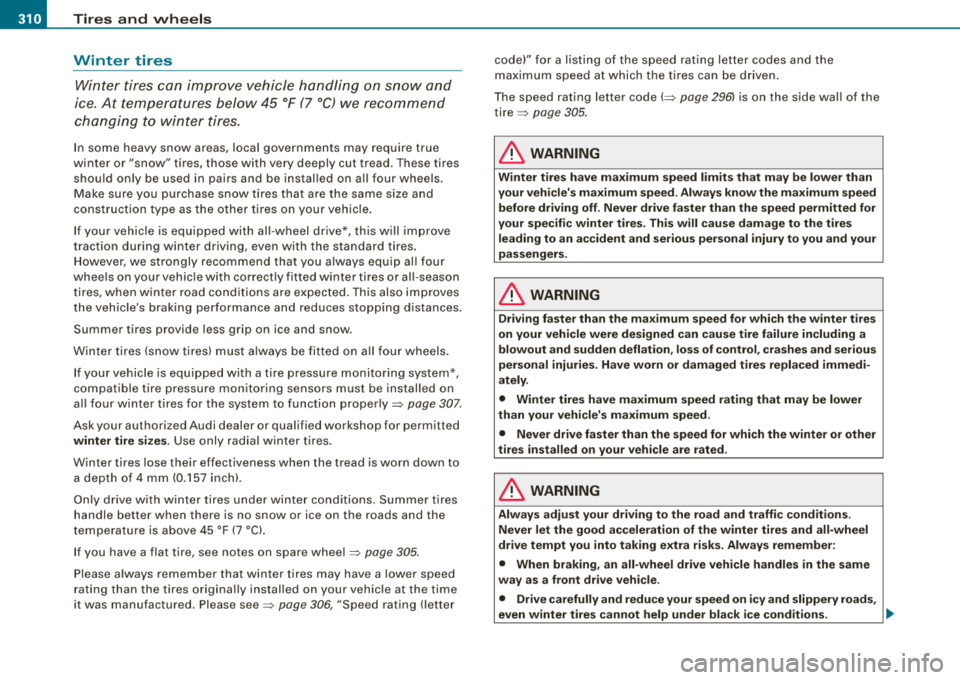
___ T_ ir_e_ s_ a_ n
_ d_ w_ h_ e_ e_l_
s _________________________________________________ _
Winter tires
Winter tires can impr ove vehicle handling on snow and
ice. At temperatures below 45 °F (7 °C) we recommend
changing to winter tires.
I n some heavy snow areas, local governments may require true
winter or "snow" tires, those with very deeply cut tread . These tires
should only be used in pairs and be instal led on a ll four wheels .
Make sure you purchase snow tires that are the same s ize and
construction type as the other tires on your vehicle .
If your vehic le is equipped with al l-wheel drive*, this will improve
traction during winter driving, even with the standard tires.
H owever, we strongly recommend that you a lways equ ip al l four
whee ls on your vehic le with correct ly fitted winter tires or all-season
t ires, when winter road conditions are expec ted. This also improves
t he vehic le's braking performance and reduces stopping distances.
Summer tires provide less grip on ice and snow.
W inter tires (snow t ires) must a lways be fi tted on a ll four wheels .
If your vehicle is equipped with a tire pressure monitoring system* ,
compatible tire pressu re monitoring sensors must be instal led on
a ll f our winter t ires for the system to function
properly=> page 307.
Ask your authorized Audi dealer or qualified workshop for permitted
winter tire size s. Use only rad ial winter tires.
Winter tires lose their effect iveness when the tread is worn down to
a depth of 4 mm (0.157 inch).
Only drive with w inter tires under winter conditions. Summer tires
handle better when there is no snow or ice on the roads and the
t emperature is above 45 °F (7 °C).
If you have a flat tire, see notes on spare
wheel=> page 305 .
Please a lways remember that winter tires may have a lower speed
rating than the tires original ly instal led on your vehicle at the ti me
it was manufactured . Please see
=> page 306 , "Speed rating (letter code)" for a listing of the speed rating letter codes and the
maximum speed at which t he tires can be d riven .
The speed rating letter
code(=> page 2961 i s on the side wa ll of the
tire => page 305.
& WARNING
Winter tire s have maximum speed limits that may be lower than
your vehi cle's ma ximum speed . Al wa ys know the ma ximum speed
before driving off . Never drive fa ster th an the speed permitted for
y our s pecifi c w inter tire s. Thi s will cau se damage to the tire s
lead ing to an a ccident and seriou s per sonal injury to you and your
p ass engers.
& WARNING
Driving fa ster th an the m aximum speed for whi ch the winte r tire s
on your vehi cle were de signed c an cause tir e failure in cluding a
blowout and sudden deflat ion , lo ss of contr ol, c rashe s and seriou s
per sonal injuries . Have worn or damaged tires repl aced immedi
ately .
• Winter tires have ma ximum speed rating that may be lower
than your vehicle' s m axi mum speed .
• Never drive faster than the speed for which the winter or other
ti re s in sta lled on you r vehi cle are r ated .
& WARNING
Always adju st your driving to the ro ad and traff ic condit ions .
Never let the good acceleration of th e win ter tire s and all-wheel
dr ive tempt you into taking extra ri sks. Al ways rem ember :
• When braking, an all -wheel driv e vehicle handle s in th e same
w ay as a front dr ive veh icle .
• Drive ca refully and redu ce your speed on i cy and slippery r oads,
e ven w inter tires cannot h elp under bl ack ice condit ions .
...,
Page 319 of 368
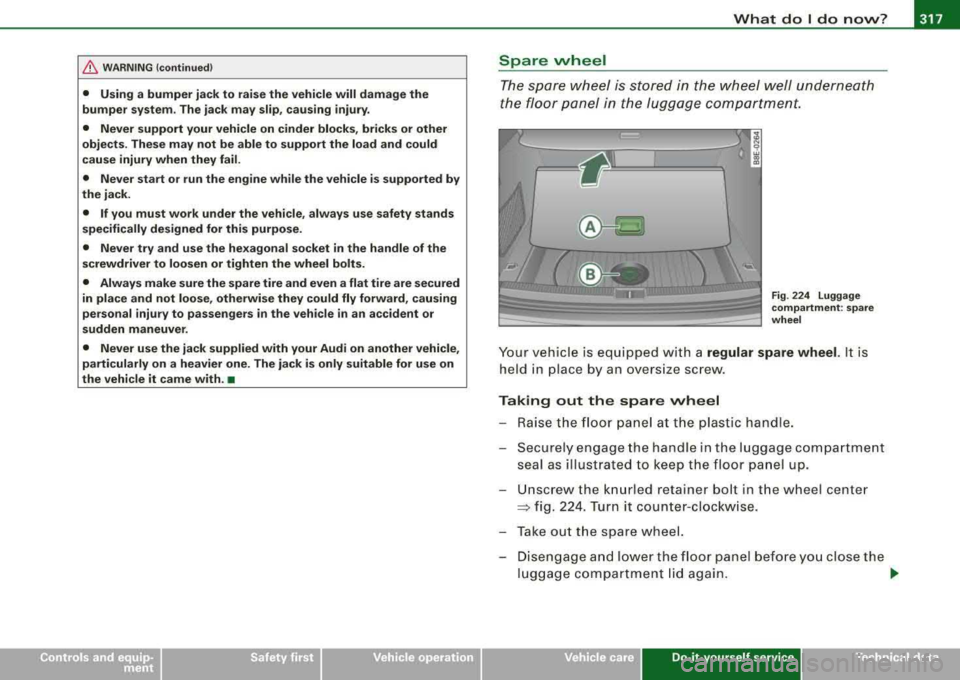
_____________________________________________ W_ h_ a_t _d_ o_l
_ d_o _ n_o_ w_ ? _ __,_
/b, WARNING (continued)
• Using a bumper jack to raise the vehicle will damage the
bumper system. The jack may slip, causing injury.
• Never support your vehicle on cinder blocks, bricks or other
objects. These may not be able to support the load and could
cause injury when they fail.
• Never start or run the engine while the vehicle is supported by
the jack.
• If you must work under the vehicle, always use safety stands
specifically designed for this purpose.
• Never try and use the hexagonal socket
in the handle of the
screwdriver to loosen or tighten the wheel bolts.
• Always make sure the spare tire and even a flat tire are secured
in place and not loose, otherwise they could fly forward, causing
personal injury to passengers in the vehicle in an accident or
sudden maneuver.
• Never use the jack supplied with your Audi on another vehicle,
particularly on a heavier one. The jack is only suitable for use on
the vehicle it came with.
•
Spare wheel
The spare wheel is stored in the wheel well underneath
the floor panel in the luggage compartment.
Fig. 224 Luggage
compartment : spare
wheel
Your vehicle is equipped with a regular spare wheel. It is
held in place by an oversize screw.
Taking out the spare wheel
- Raise the floor panel at the plastic handle.
- Securely engage the handle in the luggage compartment
seal as illustrated to keep the floor panel up.
- Unscrew the knurled retainer bolt in the wheel center
=> fig. 224. Turn it counter -clockwise .
- Take out the spare wheel.
- Disengage and lower the floor panel before you close the
luggage compartment lid again.
..,.
Do-it-yourse lf service irechnical data
Page 320 of 368

___ w_ h_ a_t _ d_ o_ l_d _ o_ n_ o_w _ ? ______________________________________________ _
Storing the replaced wheel
- Place the replaced wheel inside the spare wheel well in
the luggage compartment.
- Tighten the knurled retaining screw clockwise to secure
the wheel in place.
- Disengage and lower the floor panel before you close the
luggage compartment lid again.
& WARNING
Loose items in the passenger compartment can cause serious
personal injury during hard braking or in an accident.
• Never store the spare wheel or jack and tools
in the passenger
compartment.
• Always store all jacking equipment, tools, and the spare wheel
in the luggage compartment.
• Tighten the knurled retaining screw for the spare wheel
securely.
[ i] Tips
Check the inflation pressure of the spare tire periodically to keep the
tire ready for use. •
Wheel change
Before changing a wheel
Follow these points for your own and your passenger's
safety when replacing a wheel.
After you experience a tire failure, pull the car well away
from moving traffic and try to reach
level ground before
you
stop ~& .
-All passengers should leave the car and move to a safe
location (for instance, behind the
guardrail) ~& .
-Apply the parking brake firmly ~& .
-Move selector lever to position P on an automatic trans-
mission; put manual transmission in
first gear~& .
-If you are towing a trailer: unhitch the trailer from your
vehicle.
- Take the
tool case and the spare tire ~ page 316 out of
the luggage compartment.
& WARNING
You or your passengers could be injured while changing a wheel if
you do not follow these safety precautions:
• If you have a flat tire, move a safe distance off the road. Turn off
the engine, turn the emergency flasher on and use other warning
devices to alert other motorists.
• Make sure that passengers wait
in a safe place away from the
vehicle and well away from the roadway and traffic.
• To help prevent the vehicle from moving suddenly and possibly
slipping off the jack, always fully set the parking brake and block
the wheel diagonally opposite the wheel being changed . When one
front wheel is lifted off the ground, placing the Automatic Trans-
~